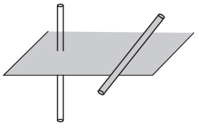Embibe Experts Solutions for Chapter: Electrostatics, Exercise 1: KVPY Aptitude Test - Stream SX (19 Nov 2017)
Embibe Experts Physics Solutions for Exercise - Embibe Experts Solutions for Chapter: Electrostatics, Exercise 1: KVPY Aptitude Test - Stream SX (19 Nov 2017)
Attempt the practice questions on Chapter 22: Electrostatics, Exercise 1: KVPY Aptitude Test - Stream SX (19 Nov 2017) with hints and solutions to strengthen your understanding. EMBIBE CHAPTER WISE PREVIOUS YEAR PAPERS FOR PHYSICS solutions are prepared by Experienced Embibe Experts.
Questions from Embibe Experts Solutions for Chapter: Electrostatics, Exercise 1: KVPY Aptitude Test - Stream SX (19 Nov 2017) with Hints & Solutions
A proton and an antiproton come close to each other in vacuum such that the distance between them is Consider the potential energy to be zero at infinity. The velocity at this distance will be:
Consider a sphere of radius with uniform charged density and total charge The electrostatic potential distribution inside the sphere is given by
Note that the zero of potential is at infinity. The values of are:
A charge is distributed over a thin ring of radius with line charge density . Note that the ring is in the -plane and is the angle made by with the -axis. The work done by the electric force in displacing a point charge from the centre of the ring to infinity is
An electrostatic field line leaves at an angle from point charge and connects with point charge at an angle (and are positive) see figure below. If and then

Two mutually perpendicular infinitely long straight conductors carrying uniformly distributed charges of linear densities and are positioned at a distance from each other.

Force between the conductors depends on as
Let the electrostatic field, at distance, from a point charge, not be an inverse square but instead an inverse cubic, e.g. , here is a constant. Consider the following two statements: (I) Flux through a spherical surface enclosing the charge is, . (II) A charge placed inside a uniformly charged shell will experience a force. Which of the above statements are valid?
The black shapes in the figure below are closed surfaces. The electric field lines are in red. For which case, the net flux through the surfaces is non-zero?

The potential due to an electrostatic charge distribution is where is positive. The net charge within a sphere centred at the origin and of radius is
